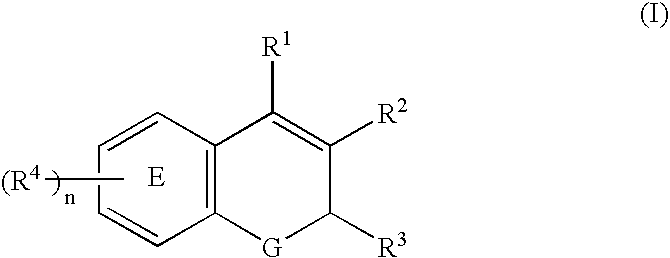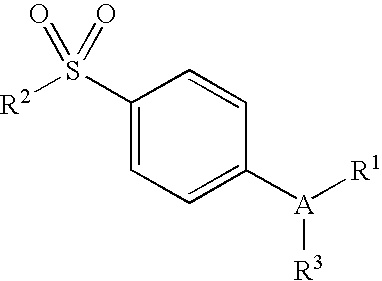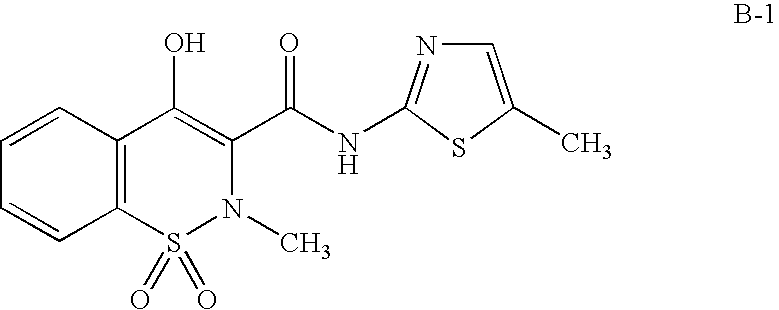Compositions of a cyclooxygenase-2 selective inhibitor and a cannabinoid agent for the treatment of central nervous system damage
a technology of cyclooxygenase and selective inhibitor, which is applied in the direction of biocide, phosphorous compound active ingredients, peptide/protein ingredients, etc., can solve the problems of brain or spinal cells losing their ability to produce energy, brain or spinal cells becoming damaged, and 10% of stroke patients becoming heavily handicapped
- Summary
- Abstract
- Description
- Claims
- Application Information
AI Technical Summary
Benefits of technology
Problems solved by technology
Method used
Image
Examples
example 1
Evaluation of COX-1 and COX-2 Activity In Vitro
[0465] The COX-2 inhibitors suitable for use in this invention exhibit selective inhibition of COX-2 over COX-1 when tested in vitro according to the following activity assays.
Preparation of Recombinant COX Baculoviruses
[0466] Recombinant COX-1 and COX-2 are prepared as described by Gierse et al, [J. Biochem., 305, 479-84 (1995)]. A 2.0 kb fragment containing the coding region of either human or murine COX-1 or human or murine COX-2 is cloned into a BamH1 site of the baculovirus transfer vector pVL1393 (Invitrogen) to generate the baculovirus transfer vectors for COX-1 and COX-2 in a manner similar to the method of D. R. O'Reilly et al (Baculovirus Expression Vectors: A Laboratory Manual (1992)). Recombinant baculoviruses are isolated by transfecting 4 μg of baculovirus transfer vector DNA into SF9 insect cells (2×108) along with 200 ng of linearized baculovirus plasmid DNA by the calcium phosphate method. See M. D. Summers and G. E...
example 2
Methods for Measuring Platelet Aggregation and Platelet Activation Markers
[0471] The following studies can be performed in human subjects or laboratory animal models, such as mice. Prior to the initiation of a clinical study involving human subjects, the study should be approved by the appropriate Human Subjects Committee and subjects should be informed about the study and give written consent prior to participation.
[0472] Platelet activation can be determined by a number of tests available in the art. Several such tests are described below. In order to determine the effectiveness of the treatment, the state of platelet activation is evaluated at several time points during the study, such as before administering the combination treatment and once a week during treatment. The exemplary procedures for blood sampling and the analyses that can be used to monitor platelet aggregation are listed below.
Platelet Aggregation Study
[0473] Blood samples are collected from an antecubital ve...
example 3
Global Ischemia and Focal Ischemia Studies
[0485] In the examples below, a combination therapy contains a cannabinoid agent and a Cox-2 selective inhibitor. The efficacy of such combination therapy can be evaluated in comparison to a control treatment such as a placebo treatment, administration of a Cox-2 inhibitor only, or administration of a cannabinoid agent only. By way of example, a combination therapy may contain 2-arachidonylglycerol and celecoxib, N-arachidonyl and valdecoxib, 5-(4-chlorophenyl)-1-(2,4-dichlorophenyl)-4-methyl-n-1-piperidinyl-1h-pyrazole-3-caroxamide (SR 141716A) and rofecoxib, or [6-methoxy-2-(4-methoxyphenyl)benzo[b]furan-3-yl](4-cyanophenyl)methanone (LY 320135) and celecoxib. It should be noted that these are only several examples, and that any of the cannabinoid agents and Cox-2 inhibitors of the present invention may be tested as a combination therapy. The dosages of a cannabinoid agent and Cox-2 inhibitor in a particular therapeutic combination may be...
PUM
| Property | Measurement | Unit |
|---|---|---|
| pH | aaaaa | aaaaa |
| pH | aaaaa | aaaaa |
| pH | aaaaa | aaaaa |
Abstract
Description
Claims
Application Information
 Login to View More
Login to View More - R&D
- Intellectual Property
- Life Sciences
- Materials
- Tech Scout
- Unparalleled Data Quality
- Higher Quality Content
- 60% Fewer Hallucinations
Browse by: Latest US Patents, China's latest patents, Technical Efficacy Thesaurus, Application Domain, Technology Topic, Popular Technical Reports.
© 2025 PatSnap. All rights reserved.Legal|Privacy policy|Modern Slavery Act Transparency Statement|Sitemap|About US| Contact US: help@patsnap.com



